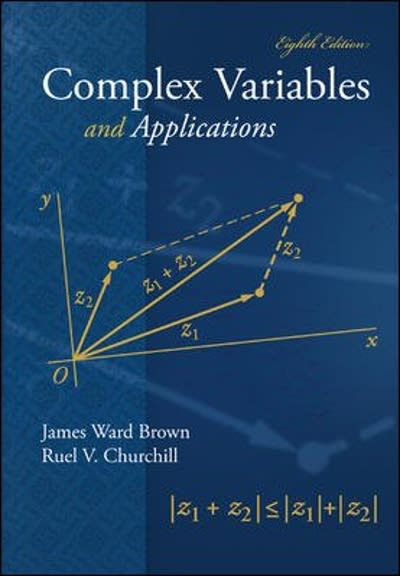Question
The following 13 questions (Q1 to Q13) are based on the following example: Patients recovering from an appendix operation normally spend an average of 6.3
The following 13 questions (Q1 to Q13) are based on the following example: Patients recovering from an appendix operation normally spend an average of 6.3 days in the hospital. The distribution of recovery times is normal with a = 1.2 days. The hospital is trying a new recovery program designed to lessen the time patients spend in the hospital. The first 10 appendix patients in this new program were released from the hospital in an average of 5.5 days. On the basis of these data, can the hospital conclude that the new program has a significant reduction of recovery time. Test at the .05 level of significance.
Q1: The appropriate statistical procedure for this example would be a
A. z-test
B. t-test
Q2: Is this a one-tailed or a two-tailed test?
A. one-tailed
B. two-tailed
Q3: The most appropriate null hypothesis (in words) would be
A. There is no statistical difference in the amount of time appendix patients spend in the hospital when comparing the new recovery program to the population of patients on the traditional recovery program.
B. There is a statistical difference in the amount of time appendix patients spend in the hospital when comparing the new recovery program to the population of patients on the traditional recovery program.
C. The new appendix recovery program does not significantly reduce the number of days spent in the hospital when compared to the population of patients on the traditional recovery program.
D. The new appendix recovery program does significantly reduce the number of days spent in the hospital when compared to the population of patients on the traditional recovery program.
Q4: The most appropriate null hypothesis (in symbols) would be
A. new program = 6.3
B. new program = 5.5
C. new program smaller than or equal 6.3
D. new program bigger than or equal 6.3
Q5: Set up the criteria for making a decision. That is, find the critical value using an alpha = .05. (Make sure you are sign specific: + ; - ; or ) (Use your tables) Summarize the data into the appropriate test statistic. Steps:
Q6: What is the numeric value of your standard error?
Q7: What is the z-value or t-value you obtained (your test statistic)?
Q8: Based on your results (and comparing your Q7 and Q5 answers) would you
A. reject the null hypothesis
B. fail to reject the null hypothesis
Q9: The best conclusion for this example would be
A. There is no statistical difference in the amount of time appendix patients spend in the hospital when comparing the new recovery program to the population of patients on the traditional recovery program.
B. There is a statistical difference in the amount of time appendix patients spend in the hospital when comparing the new recovery program to the population of patients on the traditional recovery program.
C. The new appendix recovery program does not significantly reduce the number of days spent in the hospital when compared to the population of patients on the traditional recovery program.
D. The new appendix recovery program does significantly reduce the number of days spent in the hospital when compared to the population of patients on the traditional recovery program.
Q10: Based on your evaluation of the null in Q8 and your conclusion is Q9, as a researcher you would be more concerned with a
A. Type I statistical error
B. Type II statistical error
Calculate the 99% confidence interval. Steps:
Q11: The mean you will use for this calculation is
A. 5.5
B. 6.3
Q12: What is the new critical value you will use for this calculation?
Q13: As you know, two values will be required to complete the following equation:
__________bigger than or equal smaller than or equal __________
Step by Step Solution
There are 3 Steps involved in it
Step: 1

Get Instant Access to Expert-Tailored Solutions
See step-by-step solutions with expert insights and AI powered tools for academic success
Step: 2

Step: 3

Ace Your Homework with AI
Get the answers you need in no time with our AI-driven, step-by-step assistance
Get Started


